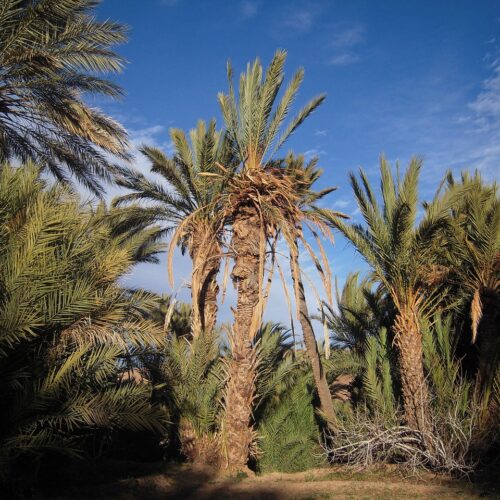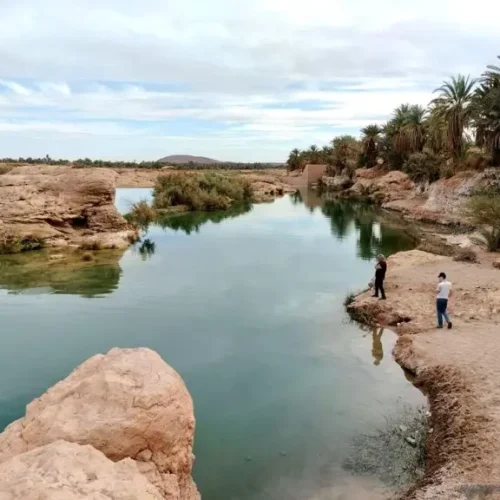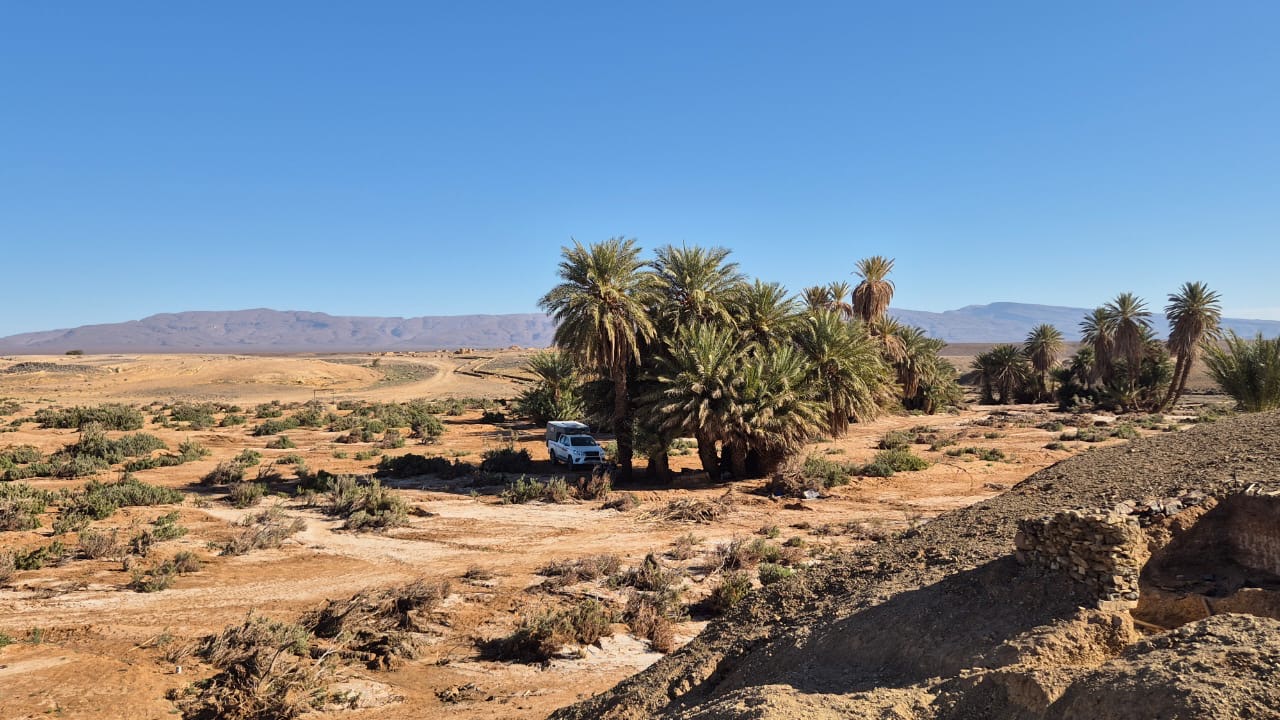Morocco’s oasis desert is a stunning mix of green and sand. Places like the Draa Valley and Skoura are green spots in the Sahara’s vast desert. These areas are full of palm trees and ancient waterways.
For years, these spots have helped nomads and traders on their desert journeys. They are true lifelines in the desert.
Travelers can see these wonders with the help of local Berber guides. They tell stories of how people survived in the desert. From hidden groves to Todra Gorge’s cliffs, each oasis has its own tale of strength.
Visiting with local guides lets you connect deeply with the area’s history. It’s a way to truly experience Morocco’s desert.
Key Takeaways
- Moroccan desert oasis landscapes blend lush greenery with dramatic desert backdrops.
- Historic trade routes once relied on these oases as critical resting points.
- Berber guides provide authentic insights into oasis farming and culture.
- Exploring via local caravan tours highlights sustainable travel practices.
- Each oasis in Morocco’s desert holds unique ecological and cultural significance.
Discovering the Hidden Gems of Morocco’s Desert Oases
The sahara desert oasis landscapes of Morocco tell stories in the sand and stone. These green spots, with palm trees against golden dunes, show more than beauty. They show how people and nature can thrive together.
What Makes Moroccan Desert Oases Unique
Here, nature and tradition work together. Ancient foggara systems bring water from underground to the surface. This water supports date palms and crops, even when it doesn’t rain.
For centuries, Berber communities have used these methods. They turn dry sand into fertile land. Each palm grove is a lesson passed down through generations.
The Historical Significance of Desert Oases in North Africa
Long ago, these oases were important meeting points. Caravans carrying valuable goods and knowledge stopped here. They were key in spreading Islam and trade across the Sahara.
Today, you can still see the old architecture and traditions. They remind us of the past.
The Ecosystem of a Desert Oasis
Underneath, a delicate balance exists. Date palms protect smaller plants from the sun. Wells and channels keep water flowing to all plants.
Even animals find a home here. Birds nest in palms, and reptiles hide near water. But this balance is fragile. Changes could harm it.
Oasis Desert Morocco: Natural Wonders That Defy the Sahara
In the Sahara’s vast expanse, oasis in the moroccan sahara stand as symbols of nature’s strength. They exist because of ancient water sources and old water systems. The Berber people have learned to use foggara tunnels to bring water up for their crops and date palms.
| Key Features | How They Work |
|---|---|
| Underground Water Networks | Hidden aquifers feed surface oases through natural pressure. |
| Traditional Irrigation | Foggara tunnels distribute water without modern machinery. |
| Plant Adaptations | Palm roots dig deep to tap into subterranean moisture. |
Local guides are like walking encyclopedias of these oases. They show us hidden springs and tell us how acacia trees store water. Desert tamarisks have silver leaves to reflect the sun, and date palms create a canopy against the wind.
- Water sources remain undiscovered by most travelers
- Guides share stories of survival passed through generations
- Traditional knowledge preserves fragile ecosystems
Visiting oasis desert morocco is like entering a desert dream come true. Each palm grove has a tale of human and plant ingenuity against the Sahara’s harshness.
Most Breathtaking Oases in the Moroccan Sahara
The Moroccan Sahara is full of hidden oases that seem like magic. These sahara desert oasis spots mix history, nature, and culture in amazing ways. You can find ancient kasbahs or peaceful palm groves, each offering a unique adventure.
Draa Valley: The Palm-Lined Wonder
The Draa Valley stretches for 100 km with rows of palm trees. Visit places like Amerhidil kasbah, where old stone walls tell stories of the past. Local guides share how these palms have thrived for centuries, turning desert into paradise.
Skoura: The Thousand Palms Oasis
Skoura is famous for its thick palm groves and old kasbahs from the 17th century. Walk paths lined with date palms and see Skoura’s strong villages. Guides show you secret springs and paths used by Berbers, proving this oasis is more than just pictures.
Fint Oasis: A Hidden Paradise
- Rare solitude: Few tourists find this secluded spot
- Traditional mud-brick homes and family-owned palm groves
- Guides here offer home-cooked meals using oasis-grown ingredients
Tinghir and Todra Gorge: Where Mountains Meet Desert
Here, red sand meets Todra Gorge’s high cliffs. The Tinghir oasis has trails to waterfalls. Guides explain how the gorge’s minerals help palm trees survive, a rare desert-water balance.
“Follow us, and we’ll show you paths where even camels stop to rest,” say caravan leaders who’ve lived here for generations.
The Berber Desert Oasis: Cultural Heritage and Traditions
The Berber communities in Morocco’s desert oases have kept ancient traditions alive. They manage water with underground khettara systems, supporting life for generations. Their farming methods, like crop rotation, make sure crops grow even in tough conditions.
Art is a big part of Berber life. Their textiles and pottery show off their skill and stories. Adobe homes keep cool and are built to last, showing their clever use of resources. Festivals like the Imilchil Marriage Festival celebrate with music and food, keeping traditions alive.
Visiting the Berber desert oasis is a unique experience. Local guides show you the daily life and the stories behind the art. They share their knowledge, making your visit more than just a sightseeing trip.
Meeting Berber artisans or joining in festivals connects you to their traditions. It’s more than just seeing sights; it’s becoming part of their culture for a moment.
Planning Your Desert Oasis Adventure in Morocco
Starting a desert oasis adventure in Morocco needs careful planning. Timing and packing are key to a great trip. Morocco oasis tours with local guides make it easier, teaching you to respect the culture and nature.
Stay away from summer’s extreme heat and winter’s cold. March to May or September to November are best. The weather is mild, perfect for exploring.
What to Pack
- Light, breathable fabrics and a wide-brimmed hat for sun protection
- Closed-toe sandals to walk on hot sand and avoid thorns
- Modest clothing to respect local customs
- Electrolyte tablets for hydration and a reusable water bottle
- A compact first-aid kit and sunscreen with SPF 50+
Getting There
Choose morocco oasis tours from local caravan agencies for easy travel. They offer 4×4 rentals, private drivers, or guided bus trips. You can start from Marrakech or Fez.
Local guides speak English or French, sharing their knowledge. They help you explore the Draa Valley or Fint. Their packages include meals, lodging, and gear, making your trip stress-free.
Immersive Experiences with Native Guides Through the Oases
Step into the desert’s past with locals who know its stories. The moroccan desert oasis experience unfolds through Berber guides. They turn trails into tales, revealing how to read the desert’s whispers. Every journey becomes a shared story.
These guides ensure that morocco oasis tours go beyond sightseeing. They offer connections deeper than maps.

Camel Treks Led by Local Berber Guides
Guided camel treks follow paths used by traders for millennia. These journeys include:
- Navigation using stars and natural landmarks
- Learning camel behavior and survival techniques
- Hearing stories of ancient trade routes and oasis histories
Overnight Stays in Traditional Desert Camps
Nights in nomadic camps immerse you in timeless traditions. Highlights include:
- Staying in handwoven tents with handcrafted furnishings
- Savoring tajine dishes cooked in communal earth ovens
- Evenings filled with Berber drum rhythms and folk songs
Cultural Exchanges with Oasis Communities
Connect with daily life through hands-on activities:
| Activity | Description |
|---|---|
| Home Visits | Assist in bread baking and hear family histories |
| Craft Workshops | Learn weaving techniques from master artisans |
| Language Exchange | Simple Berber phrases taught by locals |
These interactions, arranged through local caravan agencies, ensure respect and reciprocity. Guides act as cultural bridges. They ensure travelers leave with more than photos—they carry stories.
Desert Oasis Camping Morocco: Under the Stars Experience
As day fades, the desert oasis transforms. Desert oasis camping in Morocco offers a celestial show. Vast skies unveil constellations untouched by city lights.
Guides share Berber tales linking stars to ancient stories. This makes the desert oasis adventure a journey through time and space.
Evening unfolds with communal meals cooked in underground ferns. Savor tagine stews simmered over embers while sipping mint tea under blankets of stars. Luxury tents blend modern comfort with nomadic tradition.
They offer private bedding and solar-powered amenities. Budget options provide basic bivouacs with shared spaces. All are anchored by communal fires where stories flow as freely as the tea.
- Traditional goat-hair tents with handwoven rugs
- Luxury camps with en-suite facilities
- Shared spaces for communal storytelling
Guides ensure safety and comfort, positioning camps away from wind gusts. They frame sunset vistas. Their knowledge extends beyond stars.
They know when to light fires, how to brew tea, and which constellations signal changing seasons. This is more than camping; it’s a pact with the desert’s rhythms. As sand glows amber at dawn, the desert’s heartbeat lingers in every memory.
Culinary Delights in Morocco’s Desert Oases
In the berber desert oasis, every dish tells a story of survival and tradition. The moroccan desert oasis experience comes alive through flavors shaped by centuries of resourcefulness. Local ingredients like dates, olives, and preserved lemons blend with spices to create dishes that reflect the desert’s harsh beauty.
Traditional Berber Cuisine
Scarcity inspired innovation in Berber cooking. Berber cooks craft hearty meals from what the oasis provides:
- Mechoui: Slow-roasted lamb seasoned with cumin and salt
- Tangia: Beef stew simmered in clay pots for hours
- Tagines with prunes, almonds, and saffron, cooked over open fires
The Ritual of Mint Tea in the Desert
Serving mint tea isn’t just about refreshment—it’s an art. The ritual involves:
- Pouring tea from a height to aerate it
- Serving in small glasses as a symbol of friendship
- The three cups: bitterness, sweetness, and mildness
Dining Experiences Unique to Oasis Communities
Go beyond typical tours with these exclusive opportunities:
| Experience | Description | How to Access |
|---|---|---|
| Medfouna | Baked bread filled with herbs, cooked in hot sand | Guided meals with local families |
| Harvest Dinners | Seasonal feasts with newly picked dates and figs | Timed with agricultural cycles via caravan agencies |
| Cooking Workshops | Learn to prepare dishes like tajine from elders | Organized by native guides |
Many native caravan agencies offer hands-on cooking lessons and homestays. These tours let travelers taste the desert’s soul—one bite at a time.
Photography Guide: Capturing the Magic of Moroccan Oases

Photographing the oasis desert morocco is more than just using a good lens. Timing is key. The best time is during the golden hour, just after sunrise or before sunset. This soft light makes the lush palm groves stand out against the oasis in the moroccan sahara.
A wide-angle lens is great for capturing big landscapes. A polarizing filter helps reduce harsh desert glare. These tools are essential for capturing the beauty of the desert.
- Essentials: Dust-proof camera gear, tripod for stability, and extra batteries in extreme heat
- Settings: Shoot in RAW for editing flexibility, use aperture mode to blur busy backgrounds
- Angles: Frame palm fronds against sand dunes or contrast ancient kasbah walls with greenery
“Follow the light like a detective,” says Ahmed, a Berber guide with Sahara Caravan Tours. “The best angles change daily as shadows shift.”
Local guides like Ahmed share secret spots. They know hidden trails and viewpoints that offer amazing views. They also teach you to respect the culture by asking permission before taking photos.
They help you find the best moments, like a child watering crops or a potter working under a date palm. These moments make your photos special. Always protect your gear from sandstorms and tell stories with respect.
Sustainable Tourism in Morocco’s Fragile Oasis Ecosystems
Protecting Morocco’s desert oases is a delicate balance. sahara desert oasis landscapes face threats like water shortages and habitat loss. Smart morocco oasis tours can reduce harm while supporting local life. Here’s how travelers contribute to lasting change.
Environmental Challenges Facing Desert Oases
Key issues harming these ecosystems include:
- Water scarcity from climate shifts and overuse
- Date palm diseases reducing agricultural yields
- Waste buildup in remote travel areas
How Responsible Tourism Supports Local Communities
Eco-conscious travelers fund:
- Water-saving irrigation systems
- Community-run recycling programs
- Cultural heritage restoration projects
Eco-Friendly Tour Options
Choose tours that align with conservation goals:
| Tour Type | Eco-Features |
|---|---|
| Solar-Powered Camps | Renewable energy, solar lanterns |
| Zero-Waste Expeditions | Biodegradable products, litter cleanup programs |
| Traditional Guides | Native caravan experts share land stewardship practices |
Local guides from Berber communities often lead these tours. Their knowledge ensures trips respect cultural and environmental needs. Visitors booking these morocco oasis tours help fund schools and clean water projects. Protecting these sites today safeguards them for future generations.
Authentic Morocco Oasis Tours with Native Caravan Guides
For a desert oasis adventure like no other, pick Morocco oasis tours with native guides. These family-run tours mix old-world knowledge with today’s travel needs. They offer journeys that truly connect you with the land.
- Access restricted areas like private palm groves and family date farms
- Join seasonal activities like manual irrigation or date harvesting
- Learn ancestral knowledge through Berber guide storytelling
When choosing a tour, look for guides who live in the areas they show you. Ask about their family ties and how they give back to the community. True native tours usually have small groups (less than 10) and flexible plans. They focus on cultural experiences over strict schedules.
These tours help local projects, like fixing old water systems and supporting women’s crafts. You get unique insights and help preserve culture. Look for reviews that highlight cultural experiences, not just views.
Choosing a native guide means diving into the desert’s heart – sleeping under stars, eating in family kitchens, and walking ancient paths. It’s a journey that enriches both you and the local communities.
Conclusion: Embracing the Timeless Beauty of Morocco’s Desert Oases
Every grain of sand and every date palm has a story in Morocco’s desert oases. The moroccan desert oasis experience is more than just sunsets over dunes. It’s a journey through centuries of Berber resilience and nature’s fight against harsh landscapes.
These hidden gems, like Skoura and Fint, mix ancient traditions with the simple life of the desert. They invite travelers to slow down and enjoy moments under starlit skies.
Choosing tours led by native caravan guides supports local communities. Their knowledge turns a visit into a shared story, revealing paths only locals know. By booking eco-friendly options, you help protect the fragile ecosystems that make oasis desert morocco unique.
Imagine sipping mint tea in a tent beside nomadic families, or trekking trails where caravans once passed. These oases are living bridges between past and present. When you explore, you don’t just witness history—you become part of it.
The desert’s quiet beauty teaches patience, while its vibrant colors remind us of Earth’s resilience. As you plan your trip, seek guides who share their heritage authentically. Let the desert’s silence speak, and let its people’s warmth guide you.
The oases of Morocco are waiting—not just to be seen, but to be felt. Your journey here isn’t just a vacation. It’s a step toward keeping these timeless landscapes alive for generations to come.
